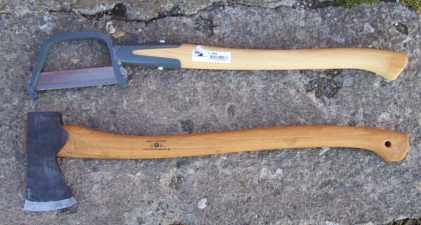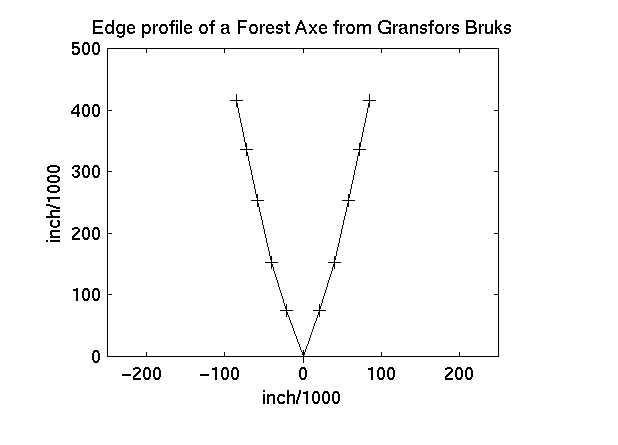
A picture of the Forest axe (bottom) alongside the Brush axe :

Concerning balance, is center head even, when suspended upside down the head will true to the middle of the handle. The center of mass of the axe is also right below the head, perfect for the traditional two handed swing. The axe goes weightless as your power hand slips up the handle and as you sweep back down the center of balance rushes out and you can thus generate a large amount of power without always having to swing such a head heavy axe.
The handle has perfect vertical grain and is shaped to allow comfort even under very heavy hits. There is however one small fault in the wood. About midpoint up the handle there is a very small knot, about 1 mm in diameter, about 5 mm in from the edge of the handle. Not something that I would let pass if I was picking out the axe. It is a small knot, and surrounded by strong wood. I don't foresee major problems. It would be more serious if it was just under the head.
The edge, just like on the Wildlife hatchet, comes nice and thin, with a high polish, however this one has a small spot that is slightly marred. It is dented and reflects light. It looks like the edge was scraped off of a piece of hardened metal by an accidental contact. Using a smooth steel I aligned the edge in that area (about 1.5 cm long) with about 20 light passes per side. Once I was finished you could just barely see light reflecting off of the edge.
Doing a simple check on push cutting sharpness, cutting light thread, I was surprised by how sharp the axe was near the toe of the bit. It would cut the thread repeatedly with just the barest hit of pressure, needing about 30 g of force to make a cut, this is at the same level of a razor blade. For reference, a well finished "shaving sharp" production knife will take about 100 g or so to cut the thread. However near the heel of the bit, the Bruks axe was not nearly as sharp taking about 175 g to make a cut, this is "hair scraping sharp". The damaged area after I steeled it needed about ~300 g. As a check of slicing sharpness I cut 1/4 inch poly under a 1000 g load. The edge took from 0.5 cm to 1.8 cm to cut through the poly. Thus parts of the edge were very sharp, as sharp or sharper as any production or custom knives, while other parts were significantly behind.
Moving beyond simple sharpness, I used the heel of the axe to do a rocking push cut through 3/8 inch poly. The axe cut through the rope with ease, biting it very strongly it was able to make complete cuts with 36 +/- 4 lbs of force. For comparison, this is the same cutting ability of the large drop point Twistmaster from Cold Steel. If this seems surprising, you have to consider that even though the cross section of the axe head is quite large, the actual edge profile is very thin and acute. Specifically here is the geometry :

This is a to scale picture, the crosses are the measured points. The edge starts off with a bevel of around 16 degrees per side but very quickly sweeps back to under ten degrees and finally hits a relief of about 6 degrees right before the start of the hollow part of the head profile. Note this is significantly more acute than most modern knives and thus the axe will easily out cut them on shallow penetration work.
Over the course of a couple of months, the axe was used to cut down several truckloads of wood. They were mainly small trees, nothing larger than a foot thick, and only a few sticks were actually that size, most were much smaller (a lot of heavy cutting in the past thinned out the heavy wood). Working on six to seven inch trees with the Forest axe clears them similar to how a nice ten inch bowie handles a 2x4. Going a bit larger onto 8-10" trees is just big enough to make you realize that you are doing some work, it still isn't a major task. Limbing however is where this axe comes into its own. The axe flies through the limbs just sweeping them off. It is balanced well for light brush cuts with a grip under the head, two handed sweeping grips for slightly larger branches and of course a full swing for branches multiple inches thick.
In regards to edge retention, sharpening and edge durability, this axe is similar to the Wildlife hatchet. It is easy to get very sharp and stays that way for quite some time, only needing a light stropping to stay sharp. When that fails to produce a razor edge, a light honing on a 1000 and then 4000 grit waterstone followed by some CrO leather stropping restored the edge back to 100%. I did however have a couple of spots of edge damage when chopping through some knotty spruce. These were trees that had rings of very hard knots. It is difficult to cut them clearly as the wood breaks poorly. I cut them mainly as an experiment, the sensible thing is to just cut higher and saw off the stump, or reduce power and take a few more hits. All that resulted from the full power swings was some minor denting that was easily repaired with no functional degredation to the axe. The axe was also chopped heavily into a rock on a bad glance later on, which again while causing some minor chipping was easily fixed with a file.
This, as you would expect, is a truely excellent axe for limbing. While it can be used for lighter cutting, it is fairly awkward becuase of the head weight and handle length and isn't a great back packing choice for that reason as well. If you wanted a multi-purpose axe in that regard you would be better off dropping in size to the small forest axe, or even the Wildlife hatchet and a decent saw to aid in felling to make up for the reduced raw chopping power.
In regards to dedicated felling, the power is quite high and very large wood would be needed to require the greater penetration afforded by a larger and heavier axe. I would however prefer a larger axe though as it would give me more reach and I would be able to cut closer to the ground. This leaves the area free of high stumps which are both wasteful and make removing the wood problematic.
I later sold the axe as I do most of my limbing with large knives, and have dedicated felling axes (35"+ handle) for cutting wood.
You can comment on this review by dropping me an email : cliffstamp[REMOVE]@cutleryscience.com or by posting in the following thread on Bladeforums :
More information can be seen at the Gransfors Bruks website.
| Last updated : | 01 : 10 : 2006 |
| Originally written: | 11 : 30 : 2001 |